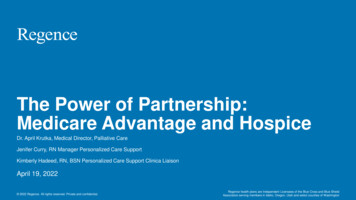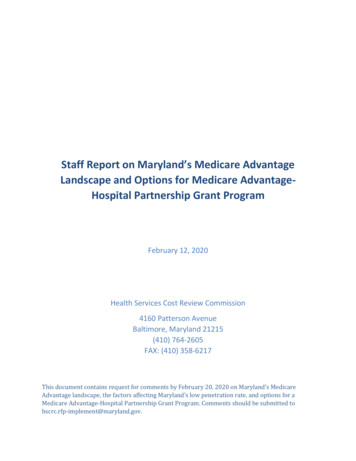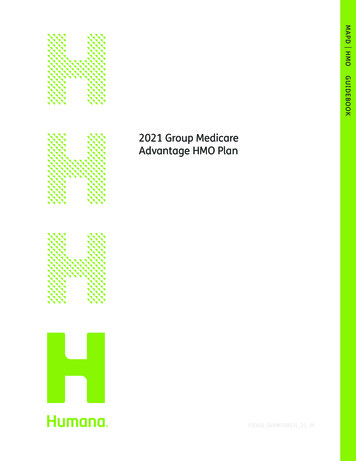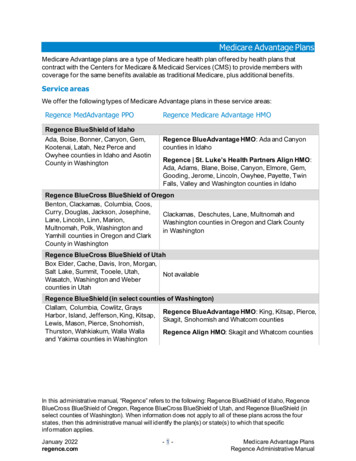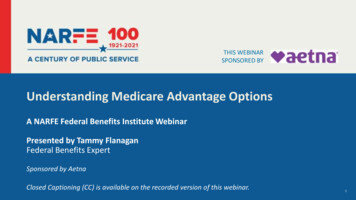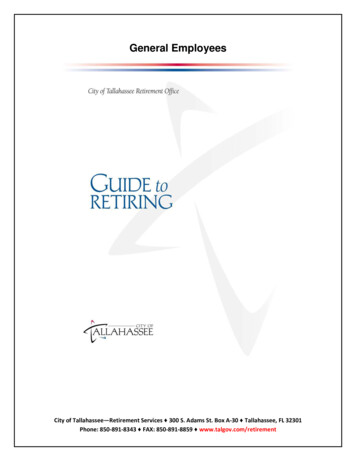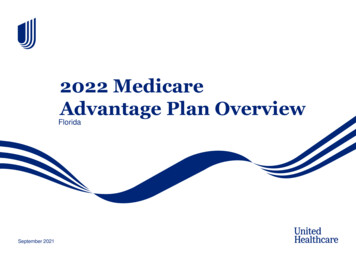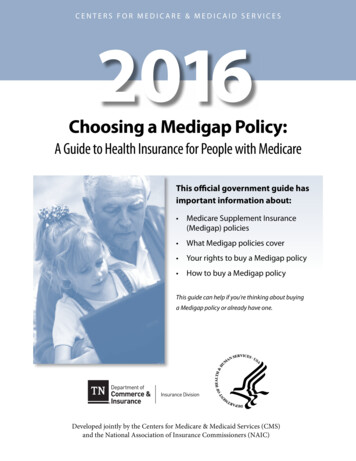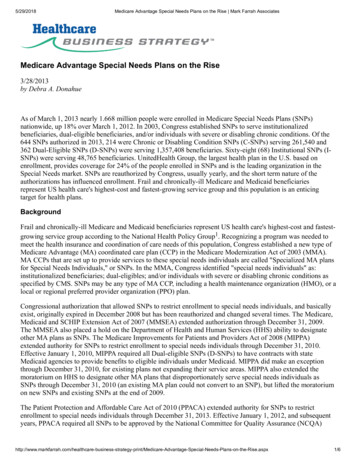
Transcription
5/29/2018Medicare Advantage Special Needs Plans on the Rise Mark Farrah AssociatesMedicare Advantage Special Needs Plans on the Rise3/28/2013by Debra A. DonahueAs of March 1, 2013 nearly 1.668 million people were enrolled in Medicare Special Needs Plans (SNPs)nationwide, up 18% over March 1, 2012. In 2003, Congress established SNPs to serve institutionalizedbeneficiaries, dual-eligible beneficiaries, and/or individuals with severe or disabling chronic conditions. Of the644 SNPs authorized in 2013, 214 were Chronic or Disabling Condition SNPs (C-SNPs) serving 261,540 and362 Dual-Eligible SNPs (D-SNPs) were serving 1,357,408 beneficiaries. Sixty-eight (68) Institutional SNPs (ISNPs) were serving 48,765 beneficiaries. UnitedHealth Group, the largest health plan in the U.S. based onenrollment, provides coverage for 24% of the people enrolled in SNPs and is the leading organization in theSpecial Needs market. SNPs are reauthorized by Congress, usually yearly, and the short term nature of theauthorizations has influenced enrollment. Frail and chronically-ill Medicare and Medicaid beneficiariesrepresent US health care's highest-cost and fastest-growing service group and this population is an enticingtarget for health plans.BackgroundFrail and chronically-ill Medicare and Medicaid beneficiaries represent US health care's highest-cost and fastestgrowing service group according to the National Health Policy Group1. Recognizing a program was needed tomeet the health insurance and coordination of care needs of this population, Congress established a new type ofMedicare Advantage (MA) coordinated care plan (CCP) in the Medicare Modernization Act of 2003 (MMA).MA CCPs that are set up to provide services to these special needs individuals are called "Specialized MA plansfor Special Needs Individuals," or SNPs. In the MMA, Congress identified "special needs individuals" as:institutionalized beneficiaries; dual-eligibles; and/or individuals with severe or disabling chronic conditions asspecified by CMS. SNPs may be any type of MA CCP, including a health maintenance organization (HMO), or alocal or regional preferred provider organization (PPO) plan.Congressional authorization that allowed SNPs to restrict enrollment to special needs individuals, and basicallyexist, originally expired in December 2008 but has been reauthorized and changed several times. The Medicare,Medicaid and SCHIP Extension Act of 2007 (MMSEA) extended authorization through December 31, 2009.The MMSEA also placed a hold on the Department of Health and Human Services (HHS) ability to designateother MA plans as SNPs. The Medicare Improvements for Patients and Providers Act of 2008 (MIPPA)extended authority for SNPs to restrict enrollment to special needs individuals through December 31, 2010.Effective January 1, 2010, MIPPA required all Dual-eligible SNPs (D-SNPs) to have contracts with stateMedicaid agencies to provide benefits to eligible individuals under Medicaid. MIPPA did make an exceptionthrough December 31, 2010, for existing plans not expanding their service areas. MIPPA also extended themoratorium on HHS to designate other MA plans that disproportionately serve special needs individuals asSNPs through December 31, 2010 (an existing MA plan could not convert to an SNP), but lifted the moratoriumon new SNPs and existing SNPs at the end of 2009.The Patient Protection and Affordable Care Act of 2010 (PPACA) extended authority for SNPs to restrictenrollment to special needs individuals through December 31, 2013. Effective January 1, 2012, and subsequentyears, PPACA required all SNPs to be approved by the National Committee for Quality Assurance Plans-on-the-Rise.aspx1/6
5/29/2018Medicare Advantage Special Needs Plans on the Rise Mark Farrah Associatesbased on standards established by HHS. PPACA also extended the exception for existing D-SNPs that do notexpand their current service areas to continue operating without contracts with state Medicaid agencies throughDecember 31, 2012.Congress intended for SNPs to enroll people with serious chronic conditions and more effectively serve highrisk populations through specialization. SNPs must offer Medicare Parts A, B, and D benefits. SNPs functionunder most of the same Medicare Advantage regulations, with some exceptions, and use the same paymentmethodology as other MA plans. The most significant exception relates to enrollment. Dual and institutionalbeneficiaries can enroll in and disenroll from a SNP anytime throughout the year. Chronic Conditionbeneficiaries have a one-time special election period, based on their being diagnosed with a condition thatqualifies them for SNP enrollment. In addition to meeting all the requirements of other MA plans, all SNPs,including Dual-eligible SNPs (D-SNPs), are required by the Centers for Medicare & Medicaid Services (CMS)to provide specialized services targeted to the needs of their beneficiaries, including a health risk assessment andan interdisciplinary care team for each beneficiary enrolled.The short term nature of the authorizations for SNPs has influenced enrollment. As of March 1, 2013 nearly1.668 million were enrolled in SNPs nationwide, up 18% over March 1, 2012. SNP enrollment in March 2013 isup 84% from the more than 906,000 people who were enrolled in May 2007, according to data released byCMS.All but six states have people enrolled in SNPs as of March 2013. The six exception states are: Alaska, Montana,North Dakota, South Dakota, Vermont and Wyoming. Windsor Health Plan offers a D-SNP in Central andWestern Montana but enrollment in this plan is less than 11 in any specific county according to CMS data as ofMarch 1, 2013.UnitedHealth Group, the largest health plan in the U.S. based on enrollment, provides coverage for 24% of thepeople enrolled in SNPs and is the leading plan in the Special Needs market. Aveta Health Care ranks second interms of SNP enrollment. Aveta, which is headquartered in New Jersey, provides coverage for SNP membersprimarily in Puerto Rico. Cigna, which acquired HealthSpring/Bravo health plans in 2012, ranks third amongleading SNP organizations as of March lans-on-the-Rise.aspx2/6
5/29/2018Medicare Advantage Special Needs Plans on the Rise Mark Farrah AssociatesEnrollment for Top SNP re46,99762,73068,590Subtotal Top 5680,685767,166812,453All Others733,737818,486855,260Total SNP Enrollment 1,414,422 1,585,652 1,667,713Source: Mark Farrah Associates (MFA) analysis of CMS enrollment data;data is available in Medicare Business Online Numbers may differ slightly from company records due to CMS' under-11 ruleAs of March 2013, CMS had approved 329 MA contracts offering 644 SNPs. The number of SNPs in 2013 isdown from the 443 MA contracts offering 769 SNPs in March 2008, but enrollment is higher than the 1.130million people enrolled in 2008. Of the 644 SNPs in 2013, 214 were Chronic or Disabling Condition SNPs (CSNPs) serving 261,540 and 362 D-SNPs were serving 1,357,408 beneficiaries. Sixty-eight (68) InstitutionalSNPs (I-SNPs) were serving 48,765 beneficiaries.Institutional SNPs (I-SNPs)I-SNPs serve the needs of those who reside or are expected to reside for 90 days or longer in a long term carefacility which is defined as a skilled nursing facility (SNF), nursing facility (NF), intermediate care facility (ICF)or inpatient psychiatric facility. I-SNPs also cover those living in the community but requiring an equivalentlevel of care to those residing in a long term care facility. Sixty percent (60%) of I-SNP enrollment is in HMOtype products, with 55% in HMOs and 5% in HMO Point of Service (HMOPOS) products. The remainder of ISNP enrollment is in local PPO products.UnitedHealthcare enrolls more than 66% of all people nationwide in I-SNPs. UnitedHealth's nearest competitorin this market is Scan Health Plan which covers 13%. Sixteen additional companies offered coverage for I-SNPenrollees as of March 2013.Chronic or Disabling Condition SNPs (C-SNPs)CMS does not provide a detailed definition of C-SNPs in regulations, leaving its options open and to theindustry's judgment on which diseases to focus on. Among the chronic conditions targeted by C-SNPs are:cardiovascular disease, diabetes, congestive heart failure (CHF), mental disorders, end stage renal disease(ESRD) and HIV/AIDS. Most enrollment is in C-SNPs covering multiple cardiovascular disorders, CHF andDiabetes ds-Plans-on-the-Rise.aspx3/6
5/29/2018Medicare Advantage Special Needs Plans on the Rise Mark Farrah AssociatesNearly 54% of C-SNP enrollment is in HMO type products, with 48% in HMOs and 6% in HMOPOS products.The remaining 46% of C-SNP enrollment is in PPO products with the majority in regional PPOs. UnitedHealthGroup's Care Improvement Plus Gold Rx (Regional PPO SNP) plan is the leading C-SNP product sold in thecountry with 23% of the 261,500 C-SNP enrollees covered by this product. UnitedHealthcare enrolls more than45% of those covered by C-SNPs.Dual-eligible SNPs (D-SNP)Nearly 93% of all D-SNP enrollment is in HMO products, with 3% or less enrolled in regional PPO, local PPOand HMOPOS products. With more than 100 companies participating in the D-SNP market, there are moreoptions for people eligible for both Medicare and Medicaid (dual- eligibles) to choose from. However,UnitedHealthcare holds more than a third of all contracts issued by CMS for D-SNP plans.Dual-eligible beneficiaries have health plan options beyond D-SNPs as well. They may choose to enroll in othertypes of SNPs for which they are eligible, including I-SNP or C-SNP. They can also enroll in other MA plans, orremain in Medicare fee-for-service (FFS). A person must be eligible for Medicare and Medicaid to enroll in a DSNP. However, Medicare Advantage plans that are not designated as a special needs plan can also enroll dualeligibles. Dual-eligible beneficiaries in D-SNPs do not necessarily get more benefits than those in other MAplans, but care coordination services are usually more comprehensive than other MA plans.D-SNPs do not cover the same categories of dual-eligible beneficiaries. Some D-SNPs may enroll all dualeligible beneficiaries or just Qualified Medicare Beneficiaries [QMB] who do not qualify for any additionalMedicaid benefits [QMB - only] or QMB pluses -- those who also meets the financial criteria for full Medicaidcoverage. Additionally, some D-SNPs are open only to disabled beneficiaries under age 65, whereas others areopen only to those aged 65 and over. Comparing various D-SNPs is difficult because of the variability inenrollment criteria.Recently, the federal government and others have focused increased attention on care coordination for dualeligible beneficiaries. PPACA required HHS to establish the Federal Coordinated Health Care Office (generallyknown as the Medicare-Medicaid Coordination Office) within CMS to more effectively integrate Medicare andMedicaid benefits and to improve federal-state coordination for dual-eligible beneficiaries to ensure that theyreceive full access to the items and services to which they are ds-Plans-on-the-Rise.aspx4/6
5/29/2018Medicare Advantage Special Needs Plans on the Rise Mark Farrah AssociatesThe Medicare-Medicaid Coordination Office, working with the Center for Medicare & Medicaid Innovation(called the Innovation Center), is beginning a financial alignment initiative that is expected to enroll up to 2million beneficiaries in 26 states and is intended to align Medicare and Medicaid services and funding so as toreduce costs while improving beneficiaries' care.The dual-eligible population is an enticing target for health plans that have seen Commercial enrollmentstagnate, especially given the growth projections for this segment. SNPs will continue as long as Congresscontinues to authorize their existence. PPACA extended authorization for SNPs through December 31, 2013.With nearly 1.7 million vulnerable people enrolled in SNPs, it is likely that the authorization will continue intothe future, especially if evidence shows that these plans improve care for the beneficiaries while reducing thefinancial burden.1National Health Policy Group (NHPG) is a Washington-based health policy group focused on improving policy and practice for frail elders, adults with disabilities, and other Medicare and Medicaidbeneficiaries with complex care needs using specialized managed care methods. NHPG works primarily with and through members of the SNP Alliance. http://www.nhpg.org/about-us.aspxAbout This DataThis brief is based on an analysis of enrollment data for Medicare Advantage Special Needs Plans released byThe Centers for Medicare and Medicaid Services (CMS). Additional sources used included CMS' Special NeedsPlan - Fact Sheet & Data Summary available at dsPlans/downloads/FSNPFACT.pdf and the Government Accounting Office report GAO-12864 titled "MEDICARE SPECIAL NEEDS PLANS CMS Should Improve Information Available about DualEligible Plans' Performance", dated September 2012.Additional information on Medicare Advantage plan enrollment, premium, product and even corrective andenforcement action data can be accessed through the CMS website or Mark Farrah Associates' MedicareBusiness Online (/products/medicare-business-online.aspx) and Medicare Benefits Analyzer (/products/medicare-benefits-analyzer.aspx). Mark Farrah Associates offers these products to make analysis oflocal markets, trends and competition easier. Enrollment data is updated monthly as soon as CMS releases newdata to save organizations from having to aggregate and organize data themselves. Premiums and benefitattributes are updated each year.About Mark Farrah Associates (MFA)Mark Farrah Associates (MFA) is a leading data aggregator and publisher providing health plan market data andanalysis tools for the healthcare industry. MFA's Medicare Business Online (MBO) product simplifies thetracking of Medicare Advantage and PDP growth and competition on a monthly basis. MBO coupled withMedicare Benefits Analyzer provides a full suite of business intelligence for the competitive MedicareAdvantage market. Committed to simplifying analysis of health insurance business, our products includeMedicare Business Online , Medicare Benefits Analyzer , Health Coverage Portal , County HealthCoverage , Health Insurer Insights , and Health Plans USA .Healthcare Business Strategy is a FREE monthly brief that presents analysis of important issues anddevelopments affecting healthcare business today. If you aren't on our email distribution list, click here rategy.aspx) to subscribe now.Debra A. Donahue is Vice President of Market Analytics & Online Products with ans-on-the-Rise.aspx5/6
5/29/2018Medicare Advantage Special Needs Plans on the Rise Mark Farrah AssociatesMark Farrah AssociatesPhone: 724.338.4100Web: www.markfarrah.com Copyright 1997-2018. All rights reserved. Unauthorized use is prohibited. Healthcare Business Strategy is the product of Mark Farrah Associates. No part of this product maybe reproduced, in any form or by any means, including posting in its entirety in blogs or other media applications, without permission in writing from Mark Farrah Associates (724) ds-Plans-on-the-Rise.aspx6/6
Group's Care Improvement Plus Gold Rx (Regional PPO SNP) plan is the leading C-SNP product sold in the country with 23% of the 261,500 C-SNP enrollees covered by this product. UnitedHealthcare enrolls more than 45% of those covered by C-SNPs. Dual-eligible SNPs (D-SNP) Nearly 93% of all D-SNP enrollment is in HMO products, with 3% or less .
